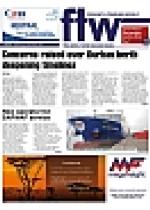Solas regulation allows for two methods of calculation
The South African
Maritime Safety
Authority (Samsa) has
voiced its concern that
to date it has received no
applications from third
party companies to act as
verification agencies for
the issue of ‘verified gross
mass’ (VGM) certificates
which will be mandatory
once new container
weighing regulations kick
in on July 1 this year.
“We are very concerned
about this as it means that
South African shippers
could then be forced
to use the only method
available to them, which
necessitates the use of
weighbridges or some
sort of warehouse scaling
system that is equipped
to weigh a full container,”
said Samsa’s Kirsty
Goodwin, speaking at a
stakeholder engagement
session at the maritime
authority’s offices
in Pretoria
last week.
The
International
Convention
for the Safety
of Life at
Sea (Solas)
regulation
for the
verification
of the weight
of a container
before it is
placed on
board a vessel
allows for two
methods of weight
verification: weighing
a packed container at a
weighbridge
(method 1) or an
equivalent scaling system
or weigh all packages,
pallets, dunnage, packing
and securing material
separately and add the tare
weight of that to the sum
(method 2).
As Goodwin explained,
the latter did not
require expensive and
sophisticated scales –
often the weight of the
individual packages was
already recorded on the
packaging. “But it does
require Samsa-approved
certification – which we
need to outsource,” she
said.
The first method of
weighing the packed
container – which would
be the only method
available to the industry
should Samsa fail to
appoint a third party to
approve and verify the
certification required for
method 2 – does require
heavy-duty scales such as
weighbridges.
And there
were
rumblings
from several
delegates at
the Samsa
session
about the
discrepancies
around the
weighing
capabilities
of the three
weighbridges that do
exist on the road between
Johannesburg and Durban
for example.
One delegate told FTW
on the sidelines of the
session that shippers and
transporters did not have
easy access to the type
of expensive weighing
equipment that was required
for method 1.
Samsa’s fears that it won’t
find a third party to manage
the approval and verification
process for
method 2 may
however be
unfounded.
Fred Thom,
business
manager for
inspection,
verification
and
certification
company
SGS,
confirmed
to FTW that his company
would soon apply. “There are
a few issues we still need to
iron out but we will get our
application in soon and we
believe we will be ready for
the July 1 deadline,” he said.
He added that he knew of
at least one other company,
a maritime surveyor, that
intended to submit an
application.
Thom believes
method 2 makes
the most sense
for shippers as
weighbridges
aren’t always as
easily accessible en
route to the ports.
And weighing the
container at the
port is out of the
question.
Dr Darren
Fraser, senior
manager: strategy
at Transnet Port
Terminals (TPT),
was unequivocal in
his assertion that
the weighbridges
at the TPT ports
would not be
used for method
1. “It will be a pre-advised
process,” he said.
INSERT
Method 2 requires
Samsa-approved
certification − which
we need to outsource.
– Kirsty Goodwin
1. Weigh container
at a weighbridge
2. Weigh contents
and add tare
weight

